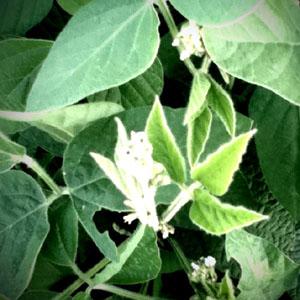Worries for Argentine soy farmers
Young soy (Photo: Julia Kumari Drapkin)
By Julia Kumari Drapkin
When the wind rustles through the trees and the air smells like wet earth, everyone in the Argentine farming town of General Villegas stops what they’re doing.
“Finally, a storm is coming,” said Gisela Giunti, who grew up here on the edge of the Argentine Pampas, about 290 miles west of Buenos Aires.
Giunti said when neighbors and friends greet each other; they don’t say “How are you?” They say “Te llovio? Did it rain to you?”
It’s an odd phrase. After all, it doesn’t rain to people. But to farmers, nature’s volatility can seem pretty personal.
“Actually, it’s a very clear way of how people feel the weather is part of their lives,” Giunti said.
She would know. Her family is full of soybean farmers. I asked her brother, Ignacio Giunti, if “it rained to him” last night. He said hardly at all. “It moistened the dust on the ground,” Ignacio said, but it wasn’t enough for his crops. A strong La Nina this year has kept Argentine farmers like Giunti on edge about drought.
Rains determine crop yields
Just outside town, fields of young soybeans and corn stretch for miles into the horizon. Without rain, the crowns on the corn crops have turned yellow. Many won’t survive. But the soy harvest still has a chance. Giunti stooped down among the knee-length greens to show me small purple flowers. The flowers mean the plants are just about to enter the critical phase. That’s the time of year when rains determine crop yields. Without water, the soy plants don’t produce beans.
Argentina is the third largest producer of soybeans behind Brazil and the United States, so it’s not just the farmers who get nervous when there isn’t enough rain. Fear of La Nina droughts helped push the price of soy beans up $150 in January. Corn and wheat hit highs too.
“This is creating a lot of nervousness on the prices,” said Sebastian Lago, who advises farmers in General Villegas about global grain markets.
“My job is to help them to sell their grains at the best prices, and what I try to tell my clients is this: in the last 10 years, we had a huge change in the financial markets. We have a lot of new players in the grain markets.”
After the stock market crash of 2001, Wall Street investors looking to diversify their portfolios discovered agricultural commodities. So now in addition to changes in the weather, Lago said, Argentine farmers have to worry about currency markets and interest rates.
Speculating with grains
“It doesn’t have anything to do with the grain markets, but it makes a lot of change in the price of the grains. Why? Because you have a lot of funds speculating with grains,” he said.
Wall Street speculators have added even more volatility to global grain markets because they’re trading food like stocks. “A stock is a part of a company,” Lago said. “But when we’re talking about a commodity, we’re talking about supply and demand.
Today, the problem is the supply. Global grain reserves are at historic lows owing to increasing demand from the world’s two biggest consumers of soy and corn. China’s rising middle class is eating more protein and importing soybeans to feed its livestock.
“China is like the video game Pac man,” Lago said. “Every year they need more soy beans. In the corn market, the Pac man is the ethanol industry in the United States.”
And Wall Street speculators are gobbling up grain commodities. At any given time investors can pull their money out of grains and move it into another market. But farmers who finance their crops with their own money, can’t be so nimble.
So Lago is helping the farmers of General Villegas develop strategies to protect themselves from the additional market volatility, especially when they’re not sure enough rain will come.
Farmers like 72-year-old Jorge Olano meet with Lago every month before the USDA publishes its monthly grain stock reports.
Of course, the first thing Lago asks Olano is if it “rained to him last night.”
Olano responds that it rained to him on both his fields. He’d like more, but it’ll do for now.
